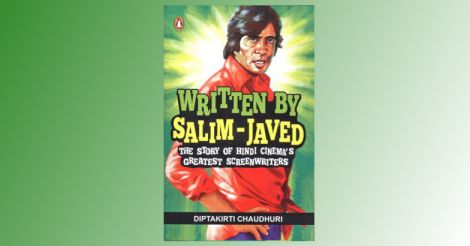Title: Written by Salim-Javed - The Story of Hindi Cinema's Greatest Screenwriters; Author: Diptakirti Chaudhuri; Publisher: Penguin Books India; Pages: 361; Price: Rs.399
Their first idea was a love story of a widower and a single mother - and had the unprecedented device of the industry's current heart-throb dying within the first hour. "Andaaz" still went on to become a super hit and laid foundations for a creative partnership that wasn't very prolific or long-standing but still gave us some of Bollywood's most enduring creations: the gritty revenge drama featuring a most unconscionable villain, a slick gangster film, tales of an angry young man railing against an unjust society or the father that refused to recognise him or one who placed duty first and many more.
But Salim-Javed's contribution to the Indian film-making was more profound than the 20-odd films they are credited with - they ensured a film's wordsmiths - story, script and dialogue writers - are accorded a central role in its making and casting, and more importantly, get the due and reumeration that had long eluded these vital but underestimated contributors. And for millions and millions of viewers, their name was enough to give a seal of approval.
As the author notes, he had experience of this first hand - settling in with his parents one Sunday evening in the early 1980s to watch Doordarhan's weekly film, which was in those days largely the sole view of Bollywood for millions of middle-class Indians, they learnt the film was the Amitabh Bachchan-starrer "Majboor". While this fact was enough to ensure the author's attention and his mother was a film buff anyway, his father, who preferred a walk instead most of the time, shuffled in his seat till the credits unrolled and he saw something that pleased him. "Arre, Salim-Javed, taholey to dekhtei hobey ("A Salim-Javed film, have to watch it then!)," he said and settled back to enjoy it.
Doing his best to fill this gap of film writing (for, not on) on the Bollywood bookshelf, Chaudhuri, a business executive-cum-writer, in his fourth book (third on Bollywood), seeks to present "the dramatic, entertaining story of the dream team that pioneered the Bollywood blockbuster", and became "game changers at a time when screenwriting was dismissed as a back-room job", influencing the fortunes of a number of actors and filmmakers and creating a gamut of cultural phenomenon, especially the the Angry Indian Man - young, old, and young redux. He notes that the Indian film industry had some more prolific and some more successful but "none of them had succeeded in changing the dynamics of an industry, notorious for being set in their ways" or advertising themselves like this duo did.
And in a feat of conscious and inspired homage, Chaudhuri seeks to present their story "in the signature Salim-Javed style - a lot of interesting event that build to a crescendo, a bit of context to make sense, but not much of analysis" - well, at least after the film, sorry, book's interval.
The book begins in the present with a brief prologue comparing their experiences of "Zanjeer" - the original of 1973 and its remake in 2013 - then flashes back to the early lives of Salim Khan, the son of a senior police officer, and Javed Akhtar, the son of a famous Urdu poet, till the time they came to India's film capital to try their luck - as an actor and a director respectively. Thrown together in an otherwise forgettable film called "Sarhadi Lootere", they found their true destiny lay in words, scenarios and plots, and this leads to the next, dealing with their decade-long partnership and 19 films (two including "Mr India" came later) from "Andaaz" (1971) to "Shakti" (1982) and including some biggies as "Haathi Mere Saathi" (1971) which proved Bollywood could incorporate animals as well as Disney, "Seeta aur Geeta" (1972) which proved the heroine could be the principal action protagonist, Yaadon ki Baraat" (1973) using the lost-and-found and vengeance tropes with a difference, "Deewar" (1975), which set Amitabh to the road of megastardom, "Trishul" and "Don" (1978) and "Shaan" (1980).
The next section details their split and subsequent solo careers, while the next two deal with the themes of their films, and their impact and legacy - the last which makes a clinical assessment of their strengths and weaknesses and posing the intriguing questions of what would have been the shape of the Indian films if they had not separated, or had turned their skills towards what is called parallel cinema- and attempts to present a counter-factual answer.
An entertaining romp through four decades and more of Bollywood and the mechanics of film making, this book is not only an illuminating account of some popular classics you may have watched multiple times but also of the importance of meaningful content - even in an escapist audio-visual show!
(With agency inputs)




































































































































































































































































































.jpg.image.160.84.jpg)





































































































































.jpg.image.160.84.jpg)











































Disclaimer
The comments posted here/below/in the given space are not on behalf of Manorama. The person posting the comment will be in sole ownership of its responsibility. According to the central government's IT rules, obscene or offensive statement made against a person, religion, community or nation is a punishable offense, and legal action would be taken against people who indulge in such activities.